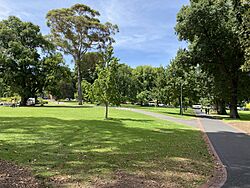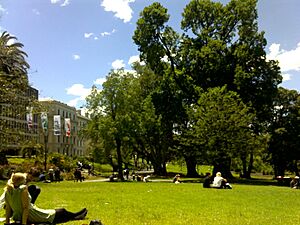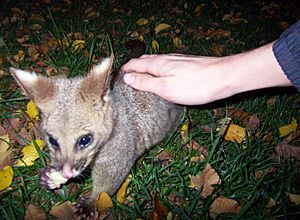Treasury Gardens facts for kids
Quick facts for kids Treasury Gardens |
|
|---|---|

Treasury Gardens during summer
|
|
| Type | Urban park |
| Location | Melbourne, Victoria, Australia |
| Area | 5.8 ha (14 acres) |
| Operated by | City of Melbourne |
| Open | All year |
| Status | Open |
| Paths | Sealed |
| Terrain | Flat |
| Vegetation | Australian Native, Lawns, Non-native traditional gardens |
| Public transit access | Parliament railway station Tram routes 48, 75 |
| Facilities | Toilets, Drinking Fountains, Seating |
| Type: | Historic |
| Designated: | 21 October 1980 |
| Reference #: | 100641 |
| Type: | State Registered Place |
| Designated: | 11 December 2003 |
| Reference #: | H1887 |
| Heritage Overlay number: | HO917 |
The Treasury Gardens is a beautiful park in Melbourne, Australia. It covers about 5.8 hectares (that's like 14 football fields!). You can find it on the south-eastern side of Melbourne's city center.
The gardens are surrounded by busy streets like Wellington Parade and Spring Street. They are also right next to the famous Fitzroy Gardens. Together, these parks make up a wonderful green space in the city.
Treasury Gardens is very special because of its history and design. It is listed on the Australian National Heritage List. This means it's an important place for everyone to enjoy and protect. People love its old design, walking paths, and amazing trees.
Contents
Exploring Treasury Gardens
The gardens are a short walk from Parliament House, where important government decisions are made. They are also near the Old Treasury Building, which is a historic landmark.
Many people who work nearby come to the gardens for lunch. They enjoy the large grassy areas and paths lined with old trees. It's a peaceful escape in the middle of the city.
Because of its central spot, the gardens are often used for community events. People gather here for rallies, demonstrations, and festivals. Tourists staying in nearby hotels also love to walk through the gardens.
Amazing Trees and Plants
Treasury Gardens is home to many different kinds of trees. You can see huge Moreton Bay fig trees and tall deodar cedars. There are also many types of elm trees, like the English elm.
Other interesting trees include the Port Jackson fig and the pedunculate oak. You might also spot some river red gums, which are native Australian trees. Along the edges, you can find colorful hydrangeas and ivy.
Wildlife in the Park
Even in the city, the gardens are full of life! At night, you might see common brushtail possums. These cute native animals are often friendly with visitors.
Other night-time creatures include grey-headed flying foxes and small insect-eating bats. During the day, look out for Pacific black ducks, red wattle birds, and silver gulls.
Memorials and History
The gardens have a lovely ornamental pond. You can also find several important memorials here:
- The Sir William John Clarke Memorial: This marble bust was put up in 1902. It honors a very important person in Victoria's history.
- The Robert Burns Memorial: This bronze statue honors a famous Scottish poet. It was moved to the gardens in 1970.
- The President John F. Kennedy Memorial: This special memorial was built in 1965. It honors the former American president and is next to the pond.
A Look Back in Time
Treasury Gardens has a long and interesting history. Here are some key moments:
- 1850s: The land was originally swampy and hard to build on. So, it was left as an open space for the city.
- 1867: Clement Hodgkinson designed the gardens. He created the crisscrossing paths and planted many trees. Willow trees were added around the pond.
- 1902: William Guilfoyle, who managed the Royal Botanic Gardens, Melbourne, turned the pond area into a Japanese Garden. This special garden was later removed after World War II.
- 1929: The City of Melbourne took over looking after the gardens.
- 1934: The community used Treasury Gardens to celebrate Victoria's 100th birthday!
- 1939: A toilet block was built. It's special because of its unique art deco design and detailed brickwork.
- 1965: The monument for American President John F. Kennedy was put in place.
- 1996: A plan was made to help manage and improve both Fitzroy and Treasury Gardens.
- 2019: About 150,000 people gathered in the gardens for a big event. It was part of the Global Climate Strike, where people spoke up about protecting our planet.
Fun Events
Every year on Australia Day (January 26), the gardens host the Share the Spirit Festival. This festival celebrates Indigenous Australian music and culture. It's a lively event with many different musicians performing.
Images for kids
-
President John F. Kennedy Memorial
-
Robert Burns statue
-
John F. Kennedy memorial plaque











